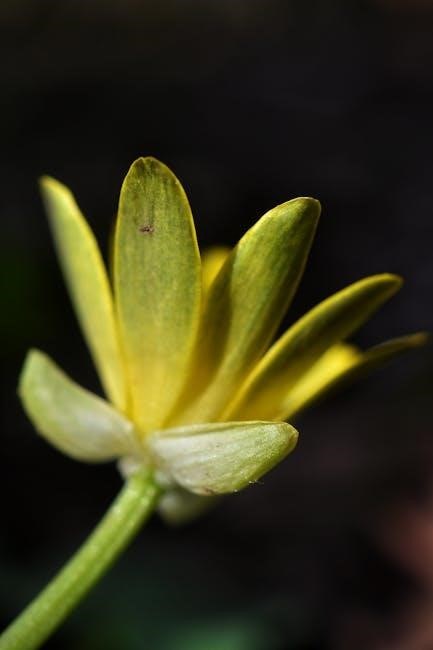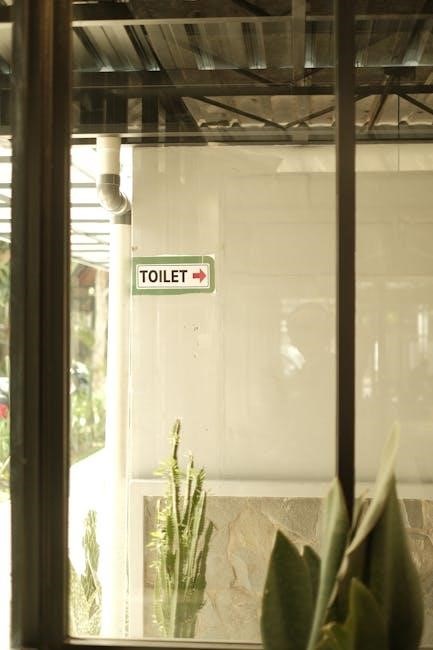Zone 8b is a USDA Hardiness Zone with average low temperatures of 15-20°F․ It offers mild winters and hot summers, ideal for diverse gardening opportunities․
1․1 Understanding USDA Hardiness Zones
The USDA Hardiness Zones divide the U․S․ into regions based on average winter temperatures, helping gardeners determine plant suitability․ Zone 8b, with lows of 15-20°F, offers a moderate climate, ideal for a wide range of plants․ Understanding these zones ensures successful plant selection and gardening outcomes․
1․2 Climate Characteristics of Zone 8b
Zone 8b experiences mild winters, with average low temperatures of 15-20°F, and hot, humid summers․ The moderate climate allows for year-round planting opportunities, with minimal frost and a long growing season․ This zone is ideal for diverse gardening, supporting both cool-season and warm-season crops with proper planning and care․

Best Time to Plant in Zone 8b
Zone 8b’s planting season begins in spring after the last frost (March-April) and extends into fall․ Plan according to weather forecasts for optimal growth and harvest success․
2․1 Spring Planting Schedule
In Zone 8b, spring planting begins in late March to early April, following the last frost date․ This period is ideal for starting cool-season crops like lettuce, radishes, and peas․ Warm-season crops such as tomatoes and peppers can be direct-sown or transplanted after the soil warms up․
2․2 Fall Planting Schedule
Fall planting in Zone 8b starts in late August to early September․ Cool-season crops like spinach, kale, and broccoli thrive in the milder temperatures․ Planting in fall allows for a second harvest before the first frost, typically occurring in late November․
2․3 Last Frost Date and Its Importance
The average last frost date for Zone 8b is around March 15․ This date is crucial as it determines when to safely plant tender crops outdoors․ Planting before this date risks damage from unexpected frosts, while waiting ensures optimal growth for warm-season plants․

Popular Plants for Zone 8b
Zone 8b’s temperate climate supports a wide variety of plants, including vegetables, flowers, shrubs, and fruits, making it an ideal location for diverse and thriving gardens year-round․
3․1 Vegetables for Zone 8b
Zone 8b’s long growing season supports a wide variety of vegetables, including tomatoes, peppers, cucumbers, and squash, which thrive in the warm climate․ Cool-season crops like spinach, lettuce, and broccoli also do well in spring and fall․
3․2 Flowers and Ornamentals for Zone 8b
Zone 8b’s climate is ideal for vibrant flowers like roses, lantana, and zinnias․ Ornamental plants such as lavender and coneflowers also thrive, attracting pollinators and adding color to gardens throughout the growing season․
3․3 Herbs and Fruits for Zone 8b
Zone 8b’s warm summers and mild winters create an ideal environment for growing a variety of herbs and fruits․ Strawberries, blueberries, raspberries, and blackberries thrive, while citrus trees, figs, and pomegranates also grow well․ Popular herbs include basil, rosemary, thyme, oregano, and mint, which flourish in the region’s climate․

Soil Preparation and Care
Zone 8b’s soil varies, with clay, sandy loam, and alluvial types common․ Amending with compost and mulch enhances fertility and drainage, promoting healthy root growth and robust plant development․
4․1 Soil Types in Zone 8b
Zone 8b features diverse soil types, including clay, sandy loam, and alluvial deposits․ These soils offer varying drainage and nutrient levels, requiring tailored amendments to optimize plant growth and root health, ensuring a thriving garden environment․
4․2 Tips for Amending Soil
Amend Zone 8b soils with compost, manure, or peat moss to enhance fertility and drainage․ Balancing pH levels and incorporating organic matter annually ensures optimal soil structure, benefiting both vegetables and ornamental plants, promoting healthy root development and robust growth throughout the growing season․
4․3 Importance of Organic Matter
Organic matter enriches soil structure, improves water retention, and supports microbial activity in Zone 8b gardens․ Regular additions of compost or manure boost nutrient availability, enhance root health, and sustain plant growth, ensuring a productive and resilient garden throughout the year․
Monthly Planting Guide
Zone 8b’s monthly planting guide includes cool-season crops in March, warm-weather plants by May, and fall crops from September to November․ Adjust based on local conditions for optimal growth․
5․1 Spring Planting (March-May)
Spring planting in Zone 8b begins in March, after the last frost date․ Start with cool-season crops like lettuce, radishes, and peas․ As temperatures rise, transition to warm-weather plants such as tomatoes, peppers, and zucchini by late April․ May is ideal for direct sowing sunflowers and summer blooms․
5․2 Summer Planting (June-August)
Summer in Zone 8b is perfect for warm-season crops․ Plant heat-tolerant varieties like okra, southern peas, and pumpkins in June․ Continue sowing beans, corn, and squash throughout July․ August is ideal for starting fall crops like broccoli and kale, ensuring a continuous harvest into cooler months․
5․3 Fall Planting (September-November)
Fall planting in Zone 8b begins in September with cool-season crops like spinach, lettuce, and radishes․ October is ideal for planting broccoli, kale, and Brussels sprouts․ By November, focus on garlic and onions for a spring harvest․ Ensure soil is prepared, and consider using cold frames to extend the growing season․

Gardening Tips for Zone 8b
Efficient watering, mulching, and pest control are essential․ Use drip irrigation to conserve water and protect plants from extreme heat․ Regularly inspect plants for pests and diseases to ensure a healthy garden․
6․1 Water Management
Efficient watering is crucial in Zone 8b’s hot climate․ Use drip irrigation to minimize evaporation and mulch to retain soil moisture․ Water deeply but infrequently to encourage root growth․ Avoid overwatering, which can lead to root rot․ Monitor soil moisture by inserting a finger into the soil up to the knuckle․
6․2 Pest Control and Prevention
Common pests in Zone 8b include aphids, whiteflies, and slugs․ Use organic pest control methods like neem oil and beneficial insects to prevent infestations․ Regularly inspect plants for early detection and employ physical barriers to protect vulnerable species․
6․3 Mulching and Weed Control
Mulching retains moisture and suppresses weeds․ Apply a 2-3 inch layer of organic mulch like wood chips or straw around plants․ Regular weeding prevents competition for nutrients․ Use physical barriers or herbicides sparingly for persistent weeds to maintain a healthy garden environment in Zone 8b․
Common Challenges in Zone 8b
Zone 8b gardeners face heat waves, pests, and soil erosion․ Managing these challenges requires proactive strategies to protect plants and maintain soil health throughout the growing season․
7․1 Dealing with Heat Waves
Zone 8b gardeners must address heat waves by ensuring proper hydration for plants․ Mulching and shading can mitigate soil temperature spikes while maintaining consistent water schedules․ Early morning watering and drought-tolerant plant selection are also effective strategies to protect gardens during intense heat periods․
7․2 Managing Pests and Diseases
In Zone 8b, managing pests and diseases requires proactive measures․ Regularly inspect plants for early detection of issues․ Use organic pest control methods like neem oil and introduce beneficial insects․ Crop rotation and proper sanitation also help prevent the spread of diseases, ensuring a healthy and thriving garden throughout the growing season․
7․3 Soil Erosion Prevention
In Zone 8b, preventing soil erosion is crucial due to heavy rains and strong winds․ Use mulch, groundcovers, and terracing to stabilize soil․ Planting native vegetation with deep roots also helps hold the soil in place, reducing erosion and maintaining soil health for optimal plant growth and garden sustainability․

Extending the Growing Season
Extend your growing season in Zone 8b using greenhouses, cold frames, and succession planting․ These methods protect crops from frost and maximize yield, allowing for year-round gardening opportunities․
8․1 Using Greenhouses
Greenhouses are excellent for extending the growing season in Zone 8b․ They protect plants from frost and extreme temperatures, allowing for year-round growth․ By controlling light, heat, and humidity, gardeners can cultivate a wide variety of crops, including those typically sensitive to temperature fluctuations, ensuring a bountiful harvest throughout the year․
8․2 Cold Frames and Season Extension
Cold frames are cost-effective tools for extending the growing season in Zone 8b․ They protect plants from frost and provide extra weeks of growth in spring and fall․ By trapping daytime heat and releasing it at night, cold frames create a microclimate ideal for cool-season crops like spinach and kale, ensuring fresh produce year-round․
8․3 Succession Planting
Succession planting maximizes garden productivity by sowing new crops as others mature․ In Zone 8b, start with cool-season crops like lettuce in spring, then transition to warm-season varieties such as tomatoes or squash․ Continue with fall crops like broccoli, ensuring a continuous harvest throughout the growing season without idle soil․
Gardening Calendar
A Zone 8b gardening calendar organizes tasks seasonally, ensuring optimal growth․ Plan for winter prep, spring planting, summer maintenance, fall harvest, and year-round soil care strategies․
9․1 January-February: Winter Prep
January and February focus on protecting perennials, planning next season, and ordering seeds․ Clean tools, review last year’s garden performance, and prepare soil for spring․ Protect plants from frost and ensure soil health by adding organic matter during these cooler months․
9․2 March-April: Spring Setup
March marks the end of frost in Zone 8b, allowing planting of warm-season crops like tomatoes and peppers․ Start seeds indoors 4-6 weeks before the last frost․ Clean up beds, apply compost, and prune shrubs․ Prepare soil for spring planting, ensuring it’s fertile and well-draining for optimal growth․
9․3 May-June: Summer Growth
May and June in Zone 8b are ideal for planting warm-season crops like tomatoes, peppers, and eggplants․ Direct sow beans, squash, and corn․ Maintain soil moisture and control weeds․ Regular harvesting encourages continuous production of crops like zucchini and berries, ensuring a bountiful summer yield․
9․4 July-August: Maintenance
Focus on consistent watering, especially during heat waves․ Mulch around plants to retain moisture and suppress weeds․ Monitor for pests like aphids and spider mites․ Prune overgrown plants and deadhead flowers to maintain health and encourage blooming․ Prepare for fall planting by clearing space and amending soil as needed․
9․5 September-October: Fall Harvest
September and October mark the peak of the fall harvest in Zone 8b․ Gather crops like squash, beans, and root vegetables before the first frost․ Clear spent plants to prepare for fall planting․ Store harvested crops properly to maintain freshness․ Monitor weather forecasts to protect plants from early frosts․
9․6 November-December: Winter Care
In November and December, focus on protecting perennials with mulch or straw and cleaning up the garden․ Remove dead plants and debris to prevent pests․ Plan next year’s garden and order seeds․ Ensure soil is prepared for spring planting by amending it during this period․

Harvesting and Storage
Harvest crops at peak ripeness to ensure quality and flavor․ Store produce in cool, dry places using appropriate containers to maintain freshness and extend shelf life․
10․1 When to Harvest
Determine harvest timing by crop type and maturity signs․ Vegetables like lettuce and peas are ready in spring, while summer crops like tomatoes and squash ripen in warmer months․ Check seed packets for “Days to Harvest” to plan accurately and avoid over-ripening for optimal flavor and yield․
10․2 Proper Storage Techniques
Store harvested crops in cool, dry, dark places to maintain freshness․ Use breathable containers for vegetables and airtight containers for seeds․ Root vegetables like carrots and beets can be stored in moist sand or straw, while fruits and herbs may require refrigeration or freezing for longer preservation and optimal quality․
10․3 Preserving the Harvest
Preserve your harvest through methods like freezing, canning, and dehydrating to enjoy year-round․ Freeze vegetables at peak ripeness for optimal flavor․ Use water bath canning for jams and pickles, while pressure canning suits low-acid foods․ Dehydrate herbs and fruits to retain nutrients and extend shelf life effectively․
Climate and Microclimates
Zone 8b has mild winters and hot summers, with microclimates offering localized growing conditions․ These smaller environments, influenced by terrain or structures, can significantly impact plant growth and survival․
11․1 Understanding Microclimates
Microclimates in Zone 8b are small areas with unique conditions, differing from the broader climate․ They are shaped by factors like topography, structures, or vegetation, creating varied temperature, humidity, and wind patterns that can affect plant growth and extend or limit the growing season․
11;2 Adjusting for Local Conditions
Local conditions in Zone 8b may vary due to topography, shade, and soil․ Observe microclimates, adjust planting schedules, and use techniques like mulching, shading, or windbreaks to protect plants․ Consider drought-resistant varieties and efficient watering systems to mitigate heat stress during summer months․
11․3 Impact of Temperature Fluctuations
Temperature fluctuations in Zone 8b can affect plant growth․ Sudden heatwaves or unseasonal frosts may stress plants․ Use season extension methods like cold frames or row covers to protect crops․ Monitor weather forecasts and plant varieties with adaptability to temperature changes for optimal resilience in your garden․
Zone 8b offers a rewarding gardening experience with its mild winters and long growing season․ For detailed guides, visit Sow True Seed or consult local nurseries for tailored advice․
12․1 Final Tips for Zone 8b Gardeners
Zone 8b’s mild winters and hot summers make it ideal for year-round gardening․ Start seeds indoors for a head start, use season extension techniques, and monitor pests․ Keep soil healthy with organic matter and water efficiently․ Plan carefully to maximize your growing season and enjoy a bountiful harvest;
12․2 Recommended Gardening Resources
For Zone 8b gardeners, resources like Sow True Seed and Stark Bros offer tailored guides․ Check out Pollock M․’s Fruit and Vegetable Planting Chart and local nursery workshops․ Online forums and gardening communities also provide valuable insights for optimizing your Zone 8b garden․